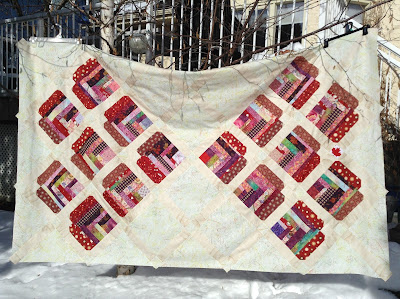I love you Canada.
You are truly beautiful.
Happy 150th Birthday 2017
and
Happy Valentine's Day!
make beautiful heart blocks.
After much contemplation I decided to go with this layout. I love how the heart blocks come together to create a beautiful heart shape at each end of the quilt and together make large "butterfly wings".
I have been admiring the low volume (tone on tone) look in quilts. I chose two cream coloured fabrics for the setting blocks, sashing, and corner stones. These background colours allow the heart blocks to be featured.
In the photo below you will notice the beautiful butterfly batik which adds to the quilt's theme.
In the next photo you will see the generous size of my setting triangles. I always cut them a bit larger than necessary so that I have room to make nice points when I add my border or binding.
Me and fabric - I only ever buy 2 metre (2 yard) cuts or more. When I make a quilt I
go to my stash, pull colours together, and start cutting. So as far as
fabric requirements go, I'm not very helpful in this area. Sorry :(
You will require:
A. Sashing Fabric.
B. Background Fabric (this will be used for background and cornerstones).
Cutting Directions for the setting of the Canadian Valentine Quilt:
Sashing:
Cut 14 - 2 1/2" WOF (width of fabric) strips of Sashing Fabric A.
Subcut into 56 Strips: 10" X 2 1/2"
Corner Sashing:
Cut 2 - 2 1/2" WOF strips of Sashing Fabric A.
Subcut into 4 Strips: 12" X 2 1/2"
Setting Blocks:
Cut 2 - 10" WOF strips of Background Fabric B.
Subcut into 6 - 10" Blocks.
Setting Triangles:
Cut 4 - 16" Squares of Background Fabric B.
Subcut each square twice on the diagonal to make 16 Setting Triangles.
Cornerstones:
Cut 3 - 2 1/2" WOF strips of Background Fabric B.
Subcut into 35 - 2 1/2" squares.
Optional: Fussy-cut one Maple Leaf block to use as a cornerstone feature.


































